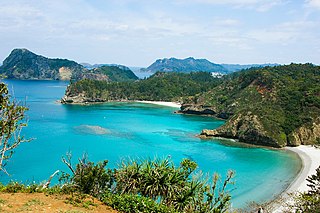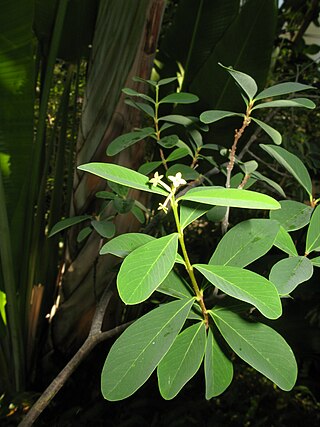
Iwo Jima, now officially romanized Iōtō, is one of the Japanese Volcano Islands, which lie south of the Bonin Islands and together with them make up the Ogasawara Archipelago. Together with the Izu Islands, they make up Japan's Nanpō Islands. Although 1,200 km (750 mi) south of Tokyo on Honshu, Iwo Jima is administered as part of the Ogasawara Subprefecture of the Tokyo Metropolitan Government.

The Bonin or Ogasawara Islands are a Japanese archipelago of over 30 subtropical and tropical islands located around 1,000 kilometers (620 mi) SSE of Tokyo and 1,600 kilometers (1,000 mi) northwest of Guam. The group as a whole has a total area of 84 square kilometers (32 sq mi) but only two of the islands are permanently inhabited, Chichijima and Hahajima. Together, their population was 2560 as of 2021. Administratively, Tokyo's Ogasawara Subprefecture includes the Volcano Islands and the Self-Defense Force post on Iwo Jima. The seat of government is Chichijima.

The Volcano Islands or Iwo Islands are a group of three Japanese-governed islands in Micronesia. They lie south of the Ogasawara Islands and belong to the municipality of Ogasawara, Tokyo, Tokyo Metropolis, Japan. The islands are all active volcanoes lying atop an island arc that stretches south to the Marianas. They have an area of 32.55 square kilometres (12.57 sq mi), and a population of 380. The island of Iwo Jima in the Volcano Islands lies about 1,240 kilometres (770 mi) southeast of Miyazaki.

Ogasawara is a village in Ogasawara Subprefecture, Tokyo Metropolis, Japan, that governs the Bonin Islands, Volcano Islands, and three remote islands.

Chichijima (父島) is the largest and most populous island in the Bonin or Ogasawara Islands. Chichijima is about 240 km (150 mi) north of Iwo Jima. 23.5 km2 (9.1 sq mi) in size, the island is home to about 2120 people (2021). Connected to the mainland only by a day-long ferry that runs a few times a month, the island is nonetheless organized administratively as the seat of Ogasawara Village in the coterminous Ogasawara Subprefecture of the Tokyo Metropolitan Government. Together with the Volcano and Izu Islands, it makes up Japan's Nanpō Islands.

Hahajima, Haha Jima, or Haha-jima is the second-largest island within the Bonin or Ogasawara Islands SSE of the Japanese Home Islands. The steeply-sloped island, which is about 21 km2 (8 sq mi) in area, has a population of 440. It is part of Ogasawara Village in Ogasawara Subprefecture, which is approximately 1,000 km (620 mi) south of Tokyo, Japan.

The Ogasawara subtropical moist forests is a terrestrial ecoregion which encompasses the Ogasawara Archipelago of Japan. The Ogasawara Archipelago lies in the Pacific Ocean south of Honshu, Japan's largest island, and north of the Marianas Islands. The ecoregion includes the Bonin Islands and Volcano Islands chains. The islands are volcanic in origin, and have never been linked to a continent. They are home to distinct plants and animals including many endemic species.

The short-tailed albatross or Steller's albatross is a large rare seabird from the North Pacific. Although related to the other North Pacific albatrosses, it also exhibits behavioural and morphological links to the albatrosses of the Southern Ocean. It was described by the German naturalist Peter Simon Pallas from skins collected by Georg Wilhelm Steller. Once common, it was brought to the edge of extinction by the trade in feathers, but with protection efforts underway since the 1950s, the species is in the process of recovering with an increasing population trend. Its breeding range, however, remains small. It has been argued that the species is actually a pair of cryptic species.

The grey-capped greenfinch or Oriental greenfinch is a small passerine bird in the finch family Fringillidae that breeds in broadleaf and conifer woodlands of the East Palearctic.

Ogasawara National Park is a national park in the Ogasawara Islands, located approximately one thousand kilometres to the south of Tokyo, Japan. The park was established in 1972 within the municipality of Ogasawara, itself part of Tokyo. In 2011, the Ogasawara Islands were inscribed upon the UNESCO World Heritage List.

The Japanese murrelet or crested murrelet is a small seabird in the auk family that occurs along the remote rocky coasts and in the offshore waters of Japan, and may also be found after the breeding season as far as Sakhalin to the north and in particular off South Korea. With a small and declining population, estimated as of 2017 to total 2,500–10,000 individuals, it is the rarest alcid, and the most at risk of extinction.

The Bonin white-eye or meguro (メグロ) is a small songbird endemic to the Bonin Islands of Japan. It is the only species in the genus Apalopteron. Its taxonomic affinities were a long-standing mystery and it has been placed with the bulbuls, babblers and more recently with the honeyeaters, during which it was known as the Bonin honeyeater. Since 1995 it is known to be a white-eye in the family Zosteropidae, that is closely related to the golden white-eye of the Marianas Islands.

Ijima's leaf warbler is a species of Old World warbler in the family Phylloscopidae. The species is native to Japan, where it has been designated a Natural Monument under the 1950 Law for the Protection of Cultural Properties, with records also from Taiwan and the Philippines.

The Bonin flying fox, Bonin fruit bat, or in Japanese Ogasawara giant bat is a species of flying fox in the family Pteropodidae. It is endemic to four islands in Ogasawara Islands, Japan. Its natural habitat is subtropical forests. It is threatened by habitat loss.

North Iwo Jima, now officially North or Kita Iōtō and previously known as Santo or San Alessandro, Hooge Meeuwen Island, and North Sulfur Island, is the northernmost member of Japan's Volcano Islands. Together with the Bonin Islands, the Volcanos form the Ogasawara Archipelago and Subprefecture. Together with the Bonins and Izu Islands, they form the Nanpo Islands, all formally organized as part of the Tokyo Metropolitan Government. North Iwo Jima is located 80 kilometers (50 mi) north of Iwo Jima, 207 kilometers (129 mi) SSW of Chichijima in the Bonins, and 1,170 kilometers (730 mi) south of Tokyo on Honshu. Previously inhabited by two Japanese villages from 1898 to 1944, it is current a desert island.

Tori-shima 'Bird Island', or Izu-Torishima 'Bird Island of Izu Province') is an uninhabited Japanese island in the Pacific Ocean. The volcanic island is part of the Izu Islands.

Wikstroemia pseudoretusa is a species of flowering plant in the family Thymelaeaceae that is endemic to the Bonin Islands, Tōkyō Metropolis, Japan.

Nakōdo-jima (媒島) is an uninhabited Japanese island in the Mukojima Islands, the northernmost island group of the Bonin Islands, in the village of Ogasawara, Tokyo Metropolis. The entire island and its surrounding waters form part of Ogasawara National Park, while an area of 147 hectares including surrounding reefs forms part of the Ogaswara Islands UNESCO World Heritage Site.

Orii Hyōjirō was a Japanese specimen collector of birds and mammals. At least a hundred new species and subspecies were described based on the type specimens he collected, a 2014 review putting the total, among taxa currently recognized, at 14 species and 41 subspecies of mammal, and 6 species and 68 subspecies of bird. The 7 mammal and 10 bird taxa named in honour of "Orii of the Orient", as he came to be known, include the Ryūkyū shrew and now-extinct Daitō varied tit.

The Bonin Islands are an archipelago of over 30 subtropical and tropical islands, some 1,000 kilometres directly south of Tokyo, Japan and 1,000 miles northwest of Guam.



















